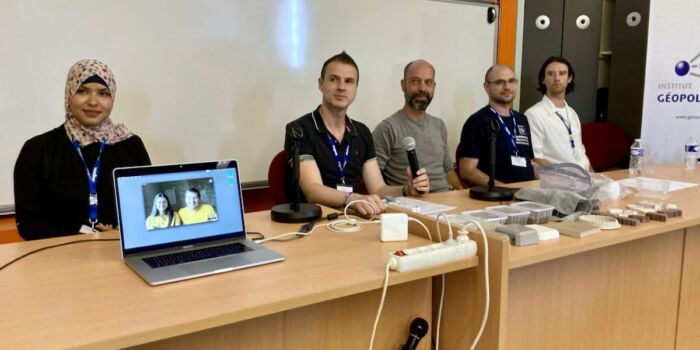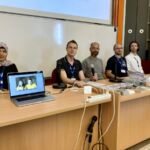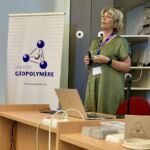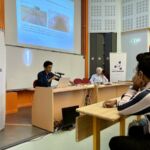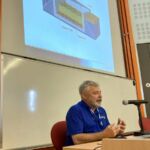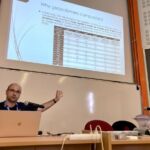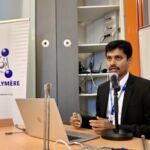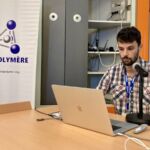The Geopolymer Camp 2023, was held on July 10th to July 12th at the Campus of the University of Picardie, in Saint-Quentin, France. You will find below the Keynote conferences, the list of short communications and some photos taken during this event.
Special Thanks to our Sponsors:
Xatico: Performance Minerals for Geopolymer Solutions
XATICO sells, distributes and advises on mineral materials, offering a wide range of carefully selected products from the world’s best production sites. Its large customer base in Europe covers many industries, including geopolymers. XATICO’s team of experts provides technical and formulation support, customised distribution, consignment stock and delivery services throughout Europe.
Geosil®: Silicate binders and hardeners for geopolymeric systems
The Geosil® product line are the first aqueous silicate solutions specifically designed for geopolymerization. In addition, Woellner supplies a wide range of additives to help you achieve your desired properties.
Geopolymer products manufacturer for the USA and North America
Website: gpi.earth
Geopolymer International is your geopolymer expert for the USA and North America. Engaged in production of a wide range of sustainable materials for manufacturing and construction based on geopolymer technology, as well as architectural concrete elements production and 3D printing.
Keynote Conference in video
State of the Geopolymer R&D 2023
Keynote by Joseph Davidovits.
31 min, 81 MB. Click on the icon on the right to watch it fullscreen.
In his keynote “State of the Geopolymer R&D 2023”, Professor Joseph Davidovits provides a comprehensive review of the advancements in geopolymer science and applications over the past year. He begins with discussing ongoing research into the fundamental geopolymerization process and new discoveries around acid-based geopolymerization. Moving into practical applications, Prof. Davidovits examines the development of super high strength metakaolins and how geopolymers can help mitigate global warming through their lower carbon footprint compared to Ordinary Portland Cement. Other timely topics covered include the role of geopolymers in sustainable water resources management and repairing critical infrastructure like roads and pavements damaged by floods. The keynote also talked about progress with 3D printing using geopolymer binders to create strong and stable ceramic-like materials. A highlight is providing details on the world’s first 3D printed house in geopolymer concrete. Lastly, Prof. Davidovits envisions future opportunities for geopolymers to enable more durable habitats for permanent settlements on the moon.
- Geopolymer Science (00:00)
- Acid-based Geopolymerization (4:52)
- New Super High Strength Metakaolins (13:04)
- Geopolymer and Global Warming (14:50)
- Management of water resources (15:54)
- Floodings and infrastructures (roads, pavements repair) (20:11)
- Geopolymer for Additive Manufacturing 3D-Printing (22:01)
- High-strength and Chemically Stable ceramic-like (24:04)
- First house printed in Geopolymer Concrete (26:07)
- Geopolymer Solutions for Lunar Habitats (28:45)
First house printed in Geopolymer Concrete in Las Vegas, USA
Keynote by William HOFF (Geopolymer International), Emmanuel ROY and Jon SCOTT (StrongPrint3D), Alex REGGIANI, Marina and Andrey DUDNIKOV (Renca).
23 min, 60 MB. Click on the CC icon to ACTIVATE SUBTITLES. Watch it fullscreen.
Two presentations are included in the video:
- (00:00) First Printed House in Geopolymer Cement, by William Hoff (Geopolymer International), Emmanuel Roy and Jon Scott (StrongPrint3D)
- Watch Jarett Gross (@automateconstruction) video: youtu.be/C-tnpkcXTuc
- (10:24) First Printed House – Fight Against the Nature, Alex Reggiani, Marina Dudnikova and Andrey Dudnikov (RENCA)
In April 2023, Geopolymer International, Renca and StrongPrint3D came together in Las Vegas, Nevada to pioneer the world’s first 3D-printed house made entirely from geopolymer cement. Despite the extreme heat and frequent winds in the Las Vegas desert, their teams worked tirelessly over several weeks, using large robotic printer equipment to layer the geopolymer cement to construct the house piece by piece directly on site. There were many challenges along the way, such as cement drying and setting quicker than expected in the hot weather. Adaptations had to be made like modifying cement mixtures. Heavy winds also disrupted prints on some days. However, through ongoing collaboration and adjustments to their process, the companies overcame these hurdles. Finally, they announced the successful completion of the fully 3D-printed house, proving the feasibility of building structures with this innovative method and opening doors to future sustainable housing applications using geopolymer materials.
Additive Manufacturing of Ceramic Type Geopolymer For Complex and Tiny Objects
Keynote by Abrar GASMI, Université Picardie Jules Verne, France, LTI – UR UPJV 3899.
26 min, 69 MB. Click on the CC icon to ACTIVATE SUBTITLES. Watch it fullscreen.
Conference presented by Abrar Gasmi, a PhD student at University Picardie Jules Verne in France, titled “Additive Manufacturing of Ceramic Type Geopolymer For Complex and Tiny Objects.” A. Gasmi discusses her research into 3D printing geopolymer materials, which are environmentally friendly ceramic-like composites. She outlines the challenges in robocasting or extrusion-based 3D printing of geopolymers. A. Gasmi explains how the rheological properties of geopolymer pastes must be characterized to determine their suitability for the 3D printing process. A variety of potential anomalies are explored, from flaws in the initial geopolymer formula to issues that can arise during and after the printing process. She shares insights on developing an optimized geopolymer formula for 3D printing through rheological testing and characterization. She highlights some of the promising results thus far in additively manufacturing complex, small-scale geopolymer prototypes.
ACCESS TO THE PRESENTATIONS
Download and read the presentations given in front of the Geopolymer Camp attendance. Click here to access to the files.
PROGRAMME
The GeopolymerCamp 2023 spanned 3 days:
SPECIAL TOPICS OF INTEREST:
– Tutorial Workshop (short courses) for Newcomers, on Monday;
– Focused Sessions dedicated to 3D Printing / Additive Manufacturing / Geopolymer Inks:
1- Geopolymer Inks for additive manufacturing of ceramic type geopolymer items, in the cm range. Experiences gathered in the Saint-Quentin Geopolymer laboratory.
2- 3D printing of a House: experiences gathered in the USA by Geopolymer International LLC (Las Vegas).
MONDAY, July 10: TUTORIAL/WORKSHOP
08:15-09:00: Registration to TUTORIAL
09:00-14:00: Workshop and tutorial with laboratory demonstrations (Groups A + B) involving 3 standard recipes.
12:00-13:00: Free Sandwich Lunch Group B
13:00-14:00: Free Sandwich Lunch Group A
14:00-16:00: Short Courses and Q&A
————————-
14:00-16:00 Registration to GEOPOLYMER CAMP
TUESDAY, July 11: GEOPOLYMER CAMP
08:30: Registration
09:00-09:15: Welcome and messages.
09:15-09:45: Keynote by Joseph Davidovits: State of the Geopolymer R&D, 2023 with special emphasis on recent developments.
09:45 First session:
Themes: geopolymer molecular chemistry; raw materials, scientific investigations.
– The need for a peer-reviewed, open access, online academic journal – the Journal of Geopolymer Chemistry and Materials, John Head, Geopolymer Industries, USA.
– Graphii Coat 30 GP™, engineered graphite geopolymer coating, Alex Reggiani, GeoMITS, Prignano Sulla Secchia, Italy.
– Joerg Lind, Wöllner GmbH, Germany: Geosil – ready to use alkali silicates for Geopolymers.
– Carine Lefèvre, Xatico, Luxembourg: Metakaolins and mineral fillers in geopolymers.
11:00-11:30: Coffee break
11:30 Second Session:
Geopolymers for Additive Manufacturing / Geopolymer Inks/ 3D printing.
– Introducing a new metakaolin for the making of Geopolymer Inks adapted to additive /3D printing, Ralph Davidovits, Geopolymer Institute and Laboratoire des Technologies Innovantes, Université de Picardie Jules Verne, France.
– Geopolymer Inks for additive manufacturing of ceramic type geopolymer items, in the cm range. Experiences gathered in the Saint-Quentin Geopolymer laboratory. Abrar Gasmi and Ralph Davidovits, Laboratoire des Technologies Innovantes, Université de Picardie Jules Verne, France.
– The relationship between maker, machine and material: Creative investigation of geopolymer extrusion 3D printing, Lennart Engels, 3D Print Workshop, School of Arts, Design and Architectur, Aalto University, Finland.
13:00 Free Sandwich Lunch
14:000 Focused Session : 3D printing of Geopolymer concrete
– Geopolymer composites and 3D printing technology to create modern solutions for Lunar and Martian habitats, Kozub Barbara, Gądek Szymon, Korniejenko Kinga, Cracow University of Technology, Cracow, Poland.
– The First 3D Printed Geopolymer House: Experiences Gathered in the USA, William Hoff, Geopolymer International LLC, Las Vegas, USA, and Emmanuel Roy, Jon Scott, StrongPrint 3D Construction Inc, Calgary, Canada.
– Renca-Geopolymer mortar for the first 3D Printed Geopolymer House, Alex Reggiani, Andrey Dudnikov, Marina Dudnikova, Renca.
15:45-16:15 Coffee break:
16:15 – 17:00 General Discussion on 3D Printing (Part 1)
WEDNESDAY, July 12 : GEOPOLYMER CAMP
9:00-09:45 Third Session:
Themes: industrial applications, foamed panels, ceramics, high temperature, binders, composites, toxic and radioactive waste containment.
– Manufacturing of fibre reinforced phosphate geopolymer composites, Sathis Kumar Selvarayan, Deutsche Institute für Textil- und Faserforschung Denkendorf, Germany.
– Alternative applications of geopolymers in the environmental industry, Miguel Otero and Lorena Freire, AIMEN Technology Centre, O Porriño (Spain).
– Recycled coffee grounds and micronized rice husk GP lightweight mortar for casting tables and tiles, Alex Reggiani, GeoMITS, Prignano Sulla Secchia, Italy.
Fourth session 09:45-12:15
Themes: building applications, eco-construction, LTGS, bricks, cements, concretes, CO2 mitigation, Global Warming.
– a) Application of Dry Grinding as an Optimisation Tool for the Surface Area development in Geopolymer Cement Manufacture and b) Predictive optimisation model for geopolymer Cement production, Zvikomborero Lazarus Duri, Naveen BP, Rajesh Arora, Rajesh Goyal, Amity International Univervisity Haryana, Gurgaon (Manesar), India and NICMAR University, Pune, India.
– Performance evaluation of Recycled Asphalt Pavement (RAP) incorporated Geopolymer Concrete for rigid pavement applications, Ghosh Ayana, Indian Institute of Technology Roorkee, India.
– The use of excavated soils into geopolymeric binders, Mouhammadou Amar, IMT-Nord Europe, CERI Matériaux et Procédés, Douai, France.
– Geopolymers as a Concrete Repair Material in Industrial Facilities Glenn Schaefer, Structural Technologies, Fulton, USA.
11:00-11:30: Coffee break.
– Development Of Semi Mobile Precast Facilities For Geopolymer Concrete Made From Chilean Copper Mining Tailings, Maarten van den Berg and Sergio Ascencio Letelier, VDB Ingeniería Circular, Santiago, Chile.
– R-EVOLUTION, geopolymer-based mortar for the production of eco-pavers, Alex Reggiani, GeoMITS, Prignano Sulla Secchia, Italy.
12:30-13:15 General Discussion on 3D Printing (Part 2)
13:15 – 15:30 Free Sandwich Lunch – Networking – Open discussions
– Groups – Discussions
– Materials Sciences + Products ; – Materials Technology & Engineering (+ civil engineering)
– Cements – Concretes (+ raw materials, adjuvants); – Sustainable / Eco Construction.

